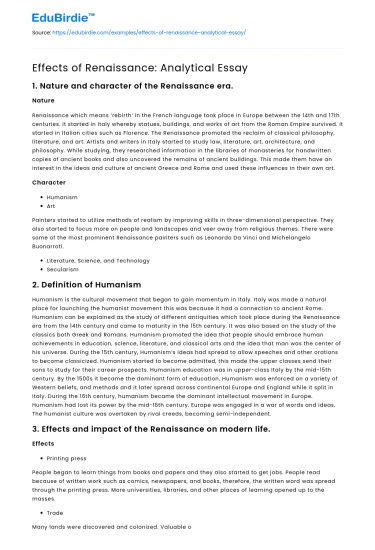1. Nature and character of the Renaissance era.
Nature
Renaissance which means ‘rebirth’ in the French language took place in Europe between the 14th and 17th centuries. It started in Italy whereby statues, buildings, and works of art from the Roman Empire survived. It started in Italian cities such as Florence. The Renaissance promoted the reclaim of classical philosophy, literature, and art. Artists and writers in Italy started to study law, literature, art, architecture, and philosophy. While studying, they researched information in the libraries of monasteries for handwritten copies of ancient books and also uncovered the remains of ancient buildings. This made them have an interest in the ideas and culture of ancient Greece and Rome and used these influences in their own art.
Character
Painters started to utilize methods of realism by improving skills in three-dimensional perspective. They also started to focus more on people and landscapes and veer away from religious themes. There were some of the most prominent Renaissance painters such as Leonardo Da Vinci and Michelangelo Buonarroti.
Save your time!
We can take care of your essay
- Proper editing and formatting
- Free revision, title page, and bibliography
- Flexible prices and money-back guarantee
- Literature, Science, and Technology
- Secularism
2. Definition of Humanism
Humanism is the cultural movement that began to gain momentum in Italy. Italy was made a natural place for launching the humanist movement this was because it had a connection to ancient Rome. Humanism can be explained as the study of different antiquities which took place during the Renaissance era from the 14th century and came to maturity in the 15th century. It was also based on the study of the classics both Greek and Romans. Humanism promoted the idea that people should embrace human achievements in education, science, literature, and classical arts and the idea that man was the center of his universe. During the 15th century, Humanism’s ideas had spread to allow speeches and other orations to become classicized. Humanism started to become admitted, this made the upper classes send their sons to study for their career prospects. Humanism education was in upper-class Italy by the mid-15th century. By the 1500s it became the dominant form of education. Humanism was enforced on a variety of Western beliefs, and methods and it later spread across continental Europe and England while it split in Italy. During the 16th century, humanism became the dominant intellectual movement in Europe. Humanism had lost its power by the mid-16th century. Europe was engaged in a war of words and ideas. The humanist culture was overtaken by rival creeds, becoming semi-independent.
3. Effects and impact of the Renaissance on modern life.
Effects
People began to learn things from books and papers and they also started to get jobs. People read because of written work such as comics, newspapers, and books, therefore, the written word was spread through the printing press. More universities, libraries, and other places of learning opened up to the masses.
Many lands were discovered and colonized. Valuable objects or resources were brought back such as gold, spices, ivory, and exotic clothes.
People started to care about each other when they started caring about Humanism they realized that everyone is important. They also began to believe human life and accomplishment had inherent value.
Less money was given to churches. This was because people began to see that churches were not doing things in the correct way, they demanded money and generally got what they wanted.
A new class of bankers, merchants, and trade people emerged as the middle class. This in turn caused people to become rich and a new way of life took over. This included larger homes, more luxuries, and more free time to be devoted to learning and developing hobbies.
Impacts
This impact came through the exploration of the New World because of this, we begin to develop colonies and new markets for trade. This, therefore, led to the development of powerful nation-states in Western Europe such as France, Portugal, England, and Spain.
This impact came in three different forms namely: Humanism, Secularism, and Printing Press.
Humanism focuses on human potential and achievements. People began to move away from the church and started to celebrate human achievements. People were less interested in God and more interested in themselves.
Secularism focuses on less religion and more focus on here and now. This means that man is perfect or can be made perfect in this world.
Printing Press made new ideas easily spread faster, they could be printed out, make copies, and distributed.
More drawings were made clear this was because the new techniques in perspective made art and sculpture more 3-dimensional. The paintings were made more lifelike (realism).
The merchant class developed power through trade and banking. The free-trade system was used throughout the industrialized world. Italian city-states dominated by Merchants.
Corruption took place in the Catholic Church which also included the sale of indulgences and the worldly lifestyles of clergy (priests and church leaders). This later led to reformation.






 Stuck on your essay?
Stuck on your essay?

